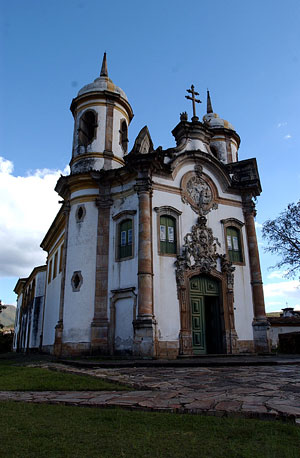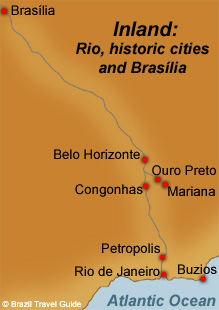BRAZILIAN HISTORY

Image on left: Ouro Preto monument; Embratur
BRAZIL: HISTORY HIGLIGHTS
- During some centuries the actual territory of Brazil has been home of some hundreds of thousands of Indians, belonging to Tupi, Ge, Aruak, and Carib groups. Human territorial density was very low, and the concentration of power and the degree of organization was far under those attained by Incas or the Mayas.
- April 22, 1500: Pedro Alvares Cabral, a Portuguese explorer, reached the coast of Brazil, at Porto Seguro, in Bahia, where they met the Pataxos Indians, the first tribe ever contacted by Europeans in South America. They still can be visited locally.
- The name of Brazil is associated to the name of a particular tropical hard wood, explored by the first Portuguese.
- Indian population was highly scattered in the territory. Calculations diverge substantially, ranging from 1 to 5 million.
- The insufficient number of Indians (aggravated by diseases and warfare with colonialists) stimulated the Portuguese to the importation of African slaves.
- In the first half of the seventeen century, the Dutch and the French have also settled themselves in Rio de Janeiro and Recife region, but not for many years. The Portuguese expelled them, and many of the Dutch settled in Brazil moved to a new colony on the island of Manhattan. Brazil is, by this way, connected to the New York City formation.
- African slaves were, at first, mainly workers of sugar plantations. The sugar was the first big business line implemented in Brazil, by the Portuguese.
- Significant numbers of slaves escaped from the sugar plantations, and found independent «quilombos» in remote areas. Portuguese military expeditions against them, failed often. Final destruction of quilombos was only achieved in late 1600, by the Bandeirantes, a well organized south Brazilian force, based in Sao Paulo region, largely responsible for the unity of Brazil.
- The relation between the African slaves and the Portuguese colonialists hasn’t attained the bitterness and the white dominance attained in North America. Black people resisted more effectively in Brazil, and their traditions and religion is still well visible in Brazilian states as Bahia.
- Around 1700 began the gold cycle, after this metals discovery, near Minas Gerais, not far from Rio de Janeiro. The gold led to the development of the central interior of Brazil. Rio de Janeiro replaced Salvador da Bahia as the Brazilian capital, in 1763.
- In 1807, King John VI of Portugal took refuge in Rio de Janeiro, after the invasion of Portugal by Napoleon, and Brazil became the seat of the Portuguese empire.
 Image on left: D. Pedro I
Image on left: D. Pedro I - The wonders of Rio de Janeiro and the tropical life of Brazil had a so great impact in the royal Portuguese family that its members persist in staying in Brazil even after Napolean was defeated. The popular discontentment in Portugal forced King John VI to return to Lisbon, but, meanwhile, Dom Pedro I – son of the king John VI - and popular Brazilian forces declared the Brazil independence in 1822. “I’m staying”, said D. Pedro I, in defiance of a decree from Lisbon, requiring his return.
 Image on left: Tiradentes
Image on left: Tiradentes - Just thirty years before, in 1789, there was a preliminary movement for brazilian independence, lead by Tiradentes (Tooth Puller, the nickname of a merchant who exercised also the activity of dentist and physician).The rebellion failed, and Tiradentes was publicly hanged in Rio and his body cut into pieces (Tiradentes is, nowadays, a national Brazilian hero, and the date of is martyrdom a national holiday).
- Pedro II (1825 - 1891), has been the second and last emperor of Brazil. He was an intellectual and a reformist, responsible for the abolition of slavery. But is success as a ruler was very limited. After some conflicts with neighbouring countries, discontentment drove Brazil to the republican system. The royal summer palace and facilities can still be visited in Petropolis, a few miles from Rio de Janeiro.
- Near the twentieth century came the rubber cycle, with the subsequent great fortunes in places like Manaus (the rubber plant was an endogenous Amazonian plant). The accumulated fortunes were so great that the richest brazilian rubber barons in Manaus used to light their cigars with bank-notes. Some magnificent monuments of Manaus, as the Opera House, are a testimony of this period. The rubber cycle collapsed with the Asian concurrence, after the «theft» of some rubber Brazilian plants.
- It was followed by the coffee and cattle ranchers cycle. For more than 50 years, Brazilian politics were deeply influenced by these productions, and by the industrialization and the emergence of Sao Paulo – actually an immediate metropolis of more than 40 million people - as the economic and industrial heart of Brazil. Most of the economic power of Brazil is now centred in Sao Paulo, and some adjacent regions like the Minas Gerais state (capital: Belo Horizonte), and, in some extent, Rio de Janeiro.
- In the sixties, a new political capital was established at Brasilia, replacing Rio de Janeiro. The expressed goal was to encourage the development of the interior. During two decades – from mid sixties till mid eighties -, Brazil was ruled by military governments, with some economic success, if we measure it by production growth.
- Democratic government was only restored in 1985. Fernando Henrique Cardoso, elected in 1994, has been responsible for the «Real Plan», an economic plan that has created a new currency (the real) and hold inflation under control.
BRAZILIAN HISTORIC TOWNS
 If you are looking for historic places, consider these three ones: Parati, Olinda, Ouro Preto… And also Belo Horizonte and Diamatina. They are true gems of the colonial Brazil. The historic heritage of the Portuguese colonial times is extremely well preserved in these towns.
If you are looking for historic places, consider these three ones: Parati, Olinda, Ouro Preto… And also Belo Horizonte and Diamatina. They are true gems of the colonial Brazil. The historic heritage of the Portuguese colonial times is extremely well preserved in these towns.Parati is the better option for those who are accommodated in Rio de Janeiro (or Sao Paulo), all the more since Paraty is located in an extremely beautiful beach zone: the Costa Verde, with astonishing places as Angra dos Reis.
Ouro Preto and Belo Horizonte
Diamantina, Ouro Preto (Black Gold, in English) and its state capital, Belo Horizonte (an hour from Rio, by plane), were at the center of 18th-century Brazilian gold rush (Ouro Preto is, according to Unesco declaration, a world cultural monument). With its many museums, churches, colonial houses and streets, Ouro Preto, Diamantina and Belo Horizonte deserve the unconditional visit of those who love ancient baroque architecture and historical places.
Belo Horizonte is the capital of Minas Gerais state, and the great hub of a vast region that includes not only Ouro Preto but also small towns as Sabará, Diamantina or Mariana, also magnificent examples of colonial and baroque architecture.
For more information, and tours:
Ouro Preto Brazil Tours
State of Minas Gerais Brazil Destinations. Colonial towns, Brazilian Gold Rush. Mines and Cultural tours. English speaking guide. Transportation.